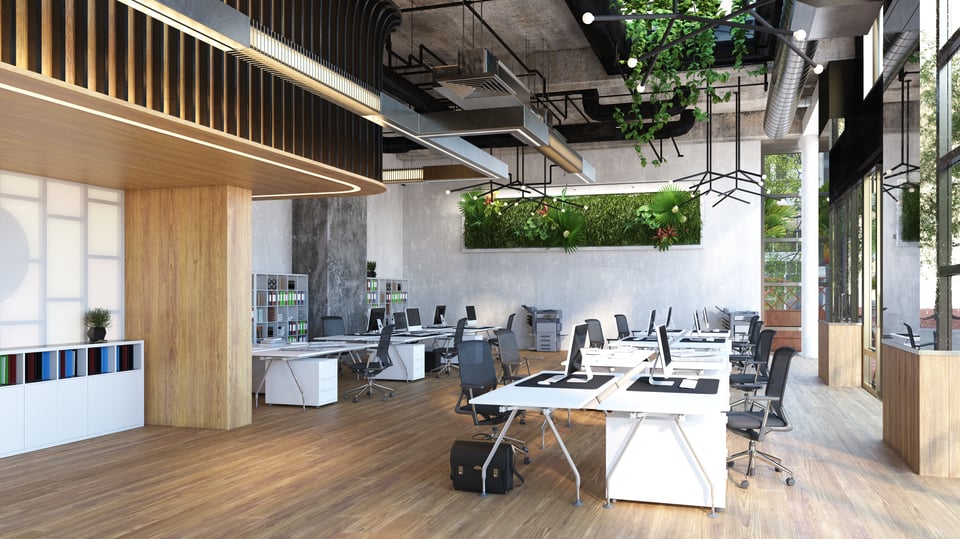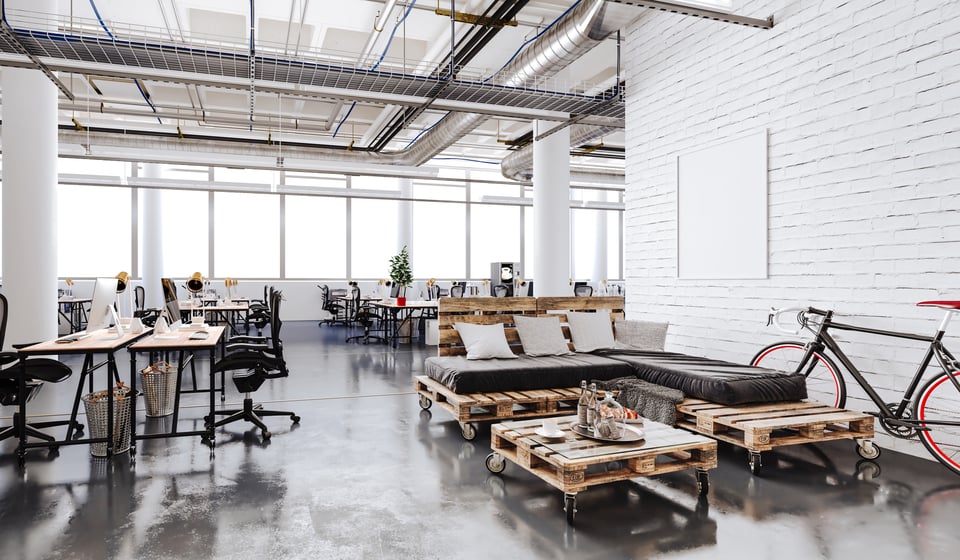Biophilic Design: How to Incorporate Natural Elements in Modern Offices
Karl Elhen
Apr 8, 2021 3:30:12 PM
An emphasis on well-being has become a significant focus for companies worldwide, especially as business owners and workers acknowledge the profound mental effects multiple lockdowns have had on them. With well-being in mind, biophilic design trends have become more prominent in workspaces.
In this blog post, we’ll discuss what biophilia is and how you can bring natural elements into built environments.

What is biophilia?
Biophilic design (also referred to as biophilia or design inspired by nature) takes humans’ inherent attraction to natural elements and channels it into design choices that stimulate well-being and focus.
If you’re thinking of bringing nature into your office designs, consider how natural elements stimulate the senses.
For example, you can stimulate sight with biomorphic patterns or colours associated with nature. You can stimulate touch with distinct textures and fabrics or by ensuring your layout choices don’t impede warmth from the sun radiating through windows.
8 Natural Trends in Office Design
There is a lot of research on the effects of biophilic design and how it enhances mindfulness in built environments. Each element or pattern that marries the natural and built environment together has a specific purpose.
The following are eight ways you can accomplish the incorporation of nature in your office:
- Living plants
- Water
- Daylight
- Airflow
- Natural materials
- Fractals
- Prospects (unimpeded views of large spaces)
- Refuge spaces
We know not every space can have a running waterfall, a floor-to-ceiling aquarium, or a living wall. So, let’s explore some more reasonable ways to use nature in your office designs.

Incorporating Wood in Office Design
Introduce raw or natural-looking (i.e., unpainted) wooden elements into the space. It’s a sturdy building material and brings more life to an office than paint or drywall.
Use wood as an accent
Where you would typically have an accent wall that highlights a focal colour or pattern, replace it with wood. The striations in the slab or planks can act as your pattern or texture, and the honey-like or oaky hues can pair well with different earth, jewel, or pastel tones that might already exist in your colour palette.
Use wood as a complementary element
Think of any place you might normally use metal or plastic and swap it out for wood to see how it takes. For example, wooden baffles can liven up any ceiling while adding acoustic benefits, and glass walls and doors trimmed with wood create visual interest without cutting off any light.

Design with wooden (or wood-looking) furniture
You can feature wood quite easily with tables in common areas and desks in work areas. However, since wooden chairs and benches aren’t exactly the most ergonomic choice in an office, you can still find ways to use wooden elements for chair or sofa legs while keeping the seats comfortable and cushioned.
Using Plants and Greenery
Incorporating actual living elements like potted plants, living walls, and succulents is the easiest way to literally bring nature into the built environment.
Plants stimulate multiple senses: sight and scent. Having them dispersed around the space, especially in common areas, can create a peaceful and mindful atmosphere. Additionally, soil’s aroma is subtle enough that it won’t disturb people with scent sensitivities like flowers might.
Low-maintenance plants. There are also plenty of plants that thrive in low-lit conditions or require minimal maintenance. For example, most succulents need very little sunlight and water to thrive, and there are many air plants, like xerographica, that operate the same way. Air plants also grow without rooting in soil, which makes them a very flexible decorative fixture.

Live plants can also help with air quality and flow in an office, and they don’t require electric or mechanical energy to do so as an air purifier would. Since indoor air quality is a critical component in human-centric, mindful office design, whatever you can do to help air ventilation without adding to the energy bill will surely excite your clients.
Harnessing Natural Light
The use of natural light is not possible in every building or room because of physical, foundational limitations, so it’s important to consider the fixtures and types of lighting you use. Although traditional incandescent lightbulbs have had a bit of a comeback in recent years (especially in the boho aesthetic), they’re not exactly conducive to a productive or natural-feeling work environment.
LED and halogen lights outperform traditional incandescent bulbs in both light quality and energy efficiency. They are often used to mimic natural light and have a broad Kelvin range to affect light colour, brightness, and quality. Certain LEDs have built-in wi-fi enablement and can be programmed to dim, brighten, or change colours on command to mimic sunlight’s natural arc.
Light fixtures also present a unique opportunity to incorporate biomorphic patterns. Pendant lights and modern metal or wooden fixtures can be constructed in fractal patterns, or they can cast those patterns throughout office spaces to create calming environments.

Manipulating Natural Light with Glass
Another way to manipulate light is by designing with glass. Allowing natural light to pass through partitions or glass architectural walls in an office creates a natural flow of warmth, movement, and life from room to room.
The manipulation of natural light can create a more open, airy feeling that can brighten any drab, stuffy office.
Refuge and Open Spaces
A refuge space provides a sense of safety, retreat, and withdrawal for a lone person or a small group. It feels separate or unique from its surrounding environment, and its design elements should elicit contemplative, embracing, or protective responses.
Alternatively, an open space with a good prospect condition feels expansive and freeing while imparting a sense of safety and control. These rooms can be communal areas in the centre of a space with lots of natural light like an atrium or spaces with broad, unimpeded views of vast areas like a stretch of feature windows on an upper floor.
Design with Balance in Mind
Striking a balance between social and private spaces is vital to modern offices. Open, shared spaces help boost engagement and stimulate workers’ social needs, and private refuge spaces help workers withdraw and refocus when they’re overly stimulated.
Besides serving biophilic functions, open and private spaces are also especially important now, considering how COVID has changed work environments. Large, open spaces can accommodate social distancing, allowing workers to interact without compromising safety, and small refuge spaces provide a place to isolate themselves from others when necessary.
Need more design inspiration? Read all about the latest trends in our 2021 Commercial Design Guide. Download the design guide now.

.png?width=960&name=Design%20Guide%20CTA%202%20(1).png)